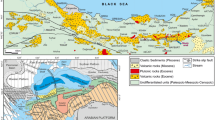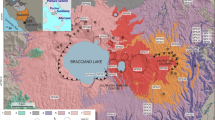Abstract
238U−230Th disequilibria and Sr and O isotope ratios have been measured in a suite of samples from most of the known prehistoric and historic eruptions of Hekla volcano, Iceland. They cover the compositional range from basaltic andesite to rhyolite. Recent basalts erupted in the vicinity of the volcano and a few Pleistocene basalts have also been studied. Geochemical data indicate that the best tracers of magmatic processes in Hekla are the (230Th/232Th) and Th/U ratios. Whereas most geochemical parameters, including Sr, Nd and O isotopes, could be compatible with crystal fractionation, (230Th/232Th) and Th/U ratios differ in the basalts and basaltic andesites (1.05 and 3.2, respectively) and in the silicic rocks, dacites and rhyolites (0.98 and 3.4–3.7, respectively). This observation precludes fractional crystallization as the main differentiation process in Hekla. On the basis of these results, the following model is proposed: basaltic magmas rise in the Icelandic crust and cause partial melting of metabasic rocks, leading to the formation of a dacitic melt. The basaltic magma itself evolves by crystal fractionation and produces a basaltic andesite magma. The latter can mix with the dacitic liquid to form andesites. At higher levels in the magma chamber, the dacitic melt sometimes undergoes further differentiation by crystal fractionation and produces subordinate volumes of rhyolites. Together all these processes lead to a zoned magma chamber. However, complete zoning is achieved only when the repose time between eruptions is long enough to allow the production of significant volumes of dacitic magma by crustal melting. This situation corresponds to the large plinian eruptions. Between these eruptions, the so-called intra-cyclic activity is characterized by the eruption of andesites and basaltic andesites, with little crustal melting. The magmatic system beneath Hekla most probably was established during the Holocene. The shape and the size of the magma chamber may be inferred from the relationships between the composition of the lavas and the location of the eruption sites. In a cross-section perpendicular to Hekla's ridge, a bell-shaped reservoir 5 km wide and 7 km deep appears the most likely; its top could be at depth of 8 km according to geophysical data.
Similar content being viewed by others
References
Allègre CJ, Condomines M (1976) Fine chronology of volcanic processes using 238U−230Th systematics. Earth Planet Sci Lett 28:395–406
Anderson AT, Clayton RN, Mayeda TK (1971) Oxygen isotope thermometry of mafic igneous rocks. J Geol 79:715–729
Baldridge WS, McGetchin TR, Frey FA, Jarosewich E (1973) Magmatic evolution of Hekla, Iceland. Contrib Mineral Petrol 42:245–258
Clayton RN, Mayeda TK (1963) The use of bromine pentafluoride in the extraction of oxygen from oxides and silicates for isotopic analyses. Geochim Cosmochim Acta 27:43–52
Condomines M, Morand P, Allègre CJ, Sigvaldason GE (1981) 230Th−238U disequilibria in historical lavas from Iceland. Earth Planet Sci Lett 55:393–406
Condomines M, Tanguy JC, Kieffer G, Allègre CJ (1982) Magmatic evolution studied by 230Th−238U disequilibrium and trace element systematics: the Etna case. Geochim Cosmochim Acta 46:1397–11416
Condomines M, Grönvold K, Hooker PJ, Muehlenbachs K, O'Nions RK, Oskarsson N, Oxburgh ER (1983) Helium, oxygen, strontium and neodymium isotopic relationships in Icelandic volcanics. Earth Planet Sci Lett 66:125–136
Condomines M, Hémond C, Allègre CJ (1988) U−Th−Ra radioactive disequilibria and magmatic processes. Earth Planet Sci Lett 90:243–262
De Paolo DJ (1981) Trace element effects of combined wallrock assimilation and fractional crystallization. Earth Planet Sci Lett 53:189–202
Einarsson Tr (1950) Chemical analysis and differentiation of Hekla's magma, eruption of Hekla 1947–1948. Soc Sci Islandica 4:1–34
Eysteinsson H, Hermance JF (1985) Magnetotelluric measurements across the eastern neovolcanic zone in south Iceland. J Geophys Res 90:10093–10103
Fukuoka T, Kigoshi K (1974) Discordant Io-ages and the uranium and thorium distribution between zircon and host rocks. Geochem J 8:117–122
Grönvold K, Larsen G, Einarsson P, Thorarinsson S, Saemundsson K (1983) The Hekla eruption 1980–1981. Bull Volcanol 46:349–363
Gundmundsson A, Oskarsson N, Grönvold K, Saemundsson K, Sigurdsson O, Stefansson R, Gislason S, Einarsson P, Brandsdottir B, Larsen G, Johannesson H, Thordarson Th (1992) The 1991 eruption of Hekla, Iceland. Bull Volcanol 54:238–246
Hart SR, Schilling J-G, Powell JL (1973) Basalts from Iceland and along the Reykjanes ridge: Sr isotope geochemistry. Nature 246:104–107
Hattori K, Muehlenbachs K (1982) Oxygen isotope ratios of the Icelandic crust. J Geophys Res 87:6559–6565
Hémond C (1986) Géochimie isotopique du thorium et du strontium dans la série tholéitique d'Islande et dans des séries calcoalcalines diverses. Thèse, Université de Paris VII, Paris, 150 pp
Hémond C, Condomines M, Fourcade S, Allègre CJ, Oskarsson N, Javoy M (1988) Thorium, strontium and oxygen isotopic geochemistry in Recent tholeiites from Iceland: crustal influence on mantle-derived magmas. Earth Planet Sci Lett 87:273–285
Jakobsson SP (1972) Chemistry and distribution pattern of Recent basaltic rocks in Iceland. Lithos 5:365–386
Jakobsson SP (1979) Petrology of Recent basalts of the eastern volcanic zone, Iceland. Acta Naturalia Islandica II 26:1–103
Johannesson H, Jakobsson SP, Saemundsson K (1982) Geological map of Iceland, sheet 6, S-Iceland, 2nd edn. Icelandic Museum of Natural History and Icelandic Geodetic Survey, Reykjavik
Kjartanson E, Grönvold K (1983) Location of a magma reservoir beneath Hekla volcano, Iceland. Nature 301:139–141
Kyser TK, O'Neil JR, Carmichael ISE (1981) Oxygen isotope thermometry of basic lavas and mantle nodules. Contrib Mineral Petrol 77:11–23
Larsen G, Thorarinsson S (1977) H4 and other acid Hekla tephra layers. Jökull 27:28–46
Le Bas MJ, Le Maitre RW, Streickeisen A, Zanettin B (1986) A chemical classification of volcanic rocks based on the total alkali-silica diagram. J Petrol 27:745–750
MacDonald R, McGarvie DW, Pinkerton H, Smith RL, Palacz ZA (1990) Petrogenetic evolution of the Torfajökull complex, Iceland I: relationship between the magma types. J Petrol 31:429–459
McGarvie DW (1984) Torfajökull — a volcano dominated by magma mixing. Geology 12:685–688
Meijer A, Kwon T-T, Tilton GR (1990) U−Th−Pb partitioning behavior during partial melting in the upper mantle: implications for the origin of high mu components and the “Pb paradox”. J Geophys Res 95:433–448
Muehlenbachs K (1973) The oxygen isotope geochemistry of siliceous volcanic rocks from Iceland. Carnegie Inst Washington Yearb 72:593–597
Muehlenbachs K, Kushiro I (1974) Oxygen isotope exchange and equilibrium in silicates with CO2 and O2. Carnegie Inst Washington Yearb 73:232–236
Muehlenbachs K, Anderson AT, Sigvaldason GE (1974) Low 18O basalts from Iceland. Geochim Comochim Acta 38:577–588
O'Nions RK, Grönvold K (1973) Petrogenetic relationship of acid and basic rocks in Iceland: Sr isotopes and rare earth elements in late and post glacial volcanics. Earth Planet Sci Lett 19:397–409
O'Nions RK, Pankhurst RJ, Grönvold K (1976) Nature and development of basalt magma sources beneath Iceland and the Reykjanes ridge. J Petrol 17:315–338
O'Nions RK, Hamilton PJ, Evensen NM (1977) Variations in 143Nd/144Nd and 87Sr/86Sr ratios in oceanic basalts. Earth Planet Sci Lett 34:13–22
Oskarsson N, Sigvaldason GE, Steinthorsson S (1982) A dynamic model of rift zone petrogenesis and the regional petrology of Iceland. J Petrol 23:28–74
Palmason G (1973) Kinematics and heat flow in a volcanic rift zone, with application to Iceland. Geophys J R Astron Soc 33:451–481
Palmason G (1986) Model of crustal formation in Iceland, and application to submarine mid-ocean ridges. In: Vogt PR, Tucholke BE (eds) The western North Atlantic region. Geological Society of America, New York, pp 87–97
Saemundsson K (1986) Subaerial volcanism in the western North Atlantic. In: Vogt PR, Tucholke BE (eds) The western North Atlantic region. Geological Society of America, New York, pp 69–85
Sigmarsson O, Hémond C, Condomines M, Fourcade S, Oskarsson N (1991) Origin of silicic magma in Iceland revealed by Thorium isotopes. Geology 19:621–624
Sigmarsson O, Condomines M, Fourcade S (1992) Mantle and crustal contribution to the genesis of basalts from off-rift zones in Iceland: constraints from Th, Sr and O isotopes. Earth Planet Sci Lett (in press)
Sigvaldason GE (1974) The petrology of Hekla and origin of silicic rocks in Iceland, eruption of Hekla 1947–1948. Soc Sci Islandica 5:1–44
Sun S-S, Jahn B-M (1975) Lead and strontium isotopes in post glacial lavas from Iceland. Nature 255:527–530
Sveinbjörnsdottir A, Coleman ML, Yardley BWD (1986) Origin of hydrothermal fluids of the Reykjanes and Krafla geothermal fields, Iceland. Contrib Mineral Petrol 94:99–109
Taylor HP Jr, Sheppard SMF (1986) Igneous rocks, I: processes of isotopic fractionation and isotope systematics. In: Valley JW, Taylor HP Jr, O'Neil JR (eds) Stable isotopes in high temperature geological processes. (Reviews in Mineralogy 16) Mineral Soc Am, Washington, D.C., pp 227–271
Thorarinsson S (1954) The tephra fall from Hekla on March 29th 1947. In: Eruption of Hekla 1947–1948. Soc Sci Islandica 2–3:1–68
Thorarinsson S (1967a) Hekla and Katla. The share of acid and intermediate lava and tephra in the volcanic products through the geological history of Iceland. In: Björnsson S (ed) Iceland and mid-ocean ridges. Soc Sci Islandica 1:190–197
Thorarinsson S (1967b) The eruption of Hekla in historical times, eruption of Hekla 1947–1948. Soc Sci Islandica 1:1–170
Thorarinsson S, Sigvaldason GE (1972) The Hekla eruption of 1970. Bull Volcanol 36:1–20
Thy P, Beard JS, Lofgren GE (1990) Experimental constraints on the origin of Icelandic rhyolites. J Geol 98:417–421
Zindler A, Hart SR, Frey FA, Jakobsson SP (1979) Nd and Sr isotope ratios and rare earth element abundances in Reykjanes Peninsula basalts: evidence for mantle heterogeneity beneath Iceland. Earth Planet Sci Lett 45:249–262
Author information
Authors and Affiliations
Rights and permissions
About this article
Cite this article
Sigmarsson, O., Condomines, M. & Fourcade, S. A detailed Th, Sr and O isotope study of Hekla: differentiation processes in an Icelandic Volcano. Contrib Mineral Petrol 112, 20–34 (1992). https://doi.org/10.1007/BF00310953
Received:
Accepted:
Issue Date:
DOI: https://doi.org/10.1007/BF00310953




